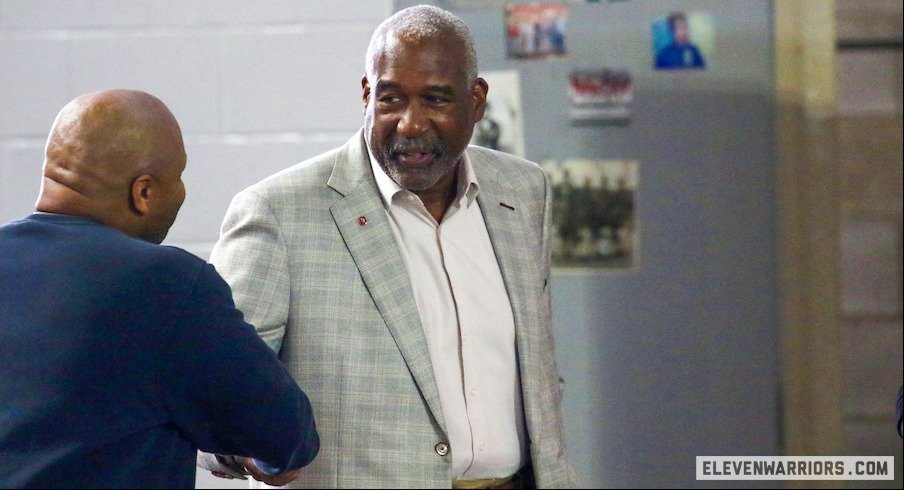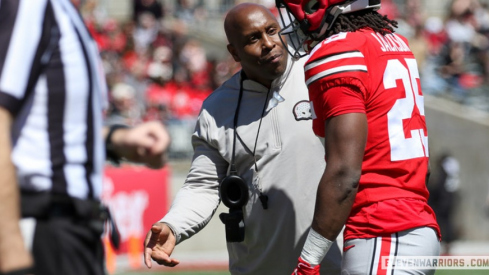With at least two new teams set to join the Big Ten in 2024, changes are coming to the way the conference schedules games.
One of those changes has already been agreed upon, according to Ohio State athletic director Gene Smith. While the conference has historically set its conference game schedules years in advance, Smith says that will no longer be the case, as Big Ten officials have decided that conference schedules for the following year will now be set “sometime in October.”
Smith said that was a change the Big Ten decided it needed to make so that it would have more flexibility in setting schedules moving forward. How exactly those schedules will be set from year to year, however, remains uncertain.
“We have made a determination that in the future, you won't know our conference games for the next year until sometime in October. We're used to having our games like five years, 10 years out. Well, that's gonna change,” Smith said Thursday. “We know it’s a model we gotta go to and include our television partners in that process. And structure it and have them be a part of the conversation. Now that we have them, we can begin that conversation and determine that type of thing. Is it based upon who's going to be strong next year? Or based upon dates or whatever. Go from there.”
One factor that still has to be determined before future schedules are set is whether or not the Big Ten will continue to have divisions. Smith says the conference has had discussions about eliminating divisions, which he is in favor of. A final decision on the future of divisions in the conference has not yet been made, but Smith expects those conversations to resume soon now that the Big Ten has finalized its new TV deal.
“We've talked about no divisions, but we haven't finalized that decision. We need to come together and finalize that decision,” Smith said. “We need to bring in (USC athletic director) Mike Bohn and (UCLA athletic director) Martin Jarmond into those conversations and start meetings around that.”
Smith believes a divisionless structure will work best for scheduling purposes when the Big Ten when USC and UCLA join the conference in 2024, while eliminating divisions would also mean the teams with the two best records across the entire conference would play in the Big Ten Championship Game each year. That said, he says the Big Ten still has to determine what its tiebreaking procedures would be for a divisionless championship game.
As for the possibility that eliminating divisions could lead to Ohio State and Michigan playing two weeks in a row with a rematch in the Big Ten Championship Game, Smith says he doesn’t think that should deter the conference from making a change that he thinks will be better for the Big Ten as a whole.
“I had that concern right when we first started this. I don't now. I got over that. It could happen,” Smith said. “At the end of the day, from a season-long scheduling point of view, when you’re bringing in USC and UCLA, when you actually get down look at it and the fact that we're trying to do the best matchups the year before in October, no divisions is better.”
It’s also possible, Smith said, that the Big Ten could eventually increase its conference game schedule from nine games to 10 games. Although Smith said he would prefer a decrease to eight conference games, that is no longer an option because of the inventory that has been promised to FOX, CBS, NBC and Peacock in the new TV deal. But he believes the Big Ten will have conversations about the possibility of a 10-game conference schedule.
“We’ll probably talk about 10 again,” Smith said. “That's always been talked about. There's a couple of ADs, they want to go to 10, they will talk about it. But no, we haven't made that decision.
While the Big Ten previously announced its conference schedules through the 2025 season back in 2018, the schedules for the next three years are likely to be significantly revamped, especially in 2024 and 2025 when USC and UCLA (and potentially more teams, as the door remains open for further conference expansion) will have to be incorporated into the conference schedule.
There’s still a lot of work to be done to figure out what Big Ten football schedules will look like beyond this season, but conference leaders will begin working through those questions more substantively now that the conference’s media rights are in place for the next eight years.
“There's just so many different things we need to ultimately get to that we just haven't gotten to yet. Because we were so focused on this (the TV deal),” Smith said. “And (Big Ten commissioner Kevin Warren)’s done a great job with this. The negotiations were, like he said publicly, a chessboard. And really, the moves were unbelievable and he did a great job at masterminding this. But now we got to get down to the work, we got to get to the details.
“There's just a lot of work to be done, and we're ready to roll up our sleeves with our new partners in the mix and try and determine what's best for us moving forward.”


